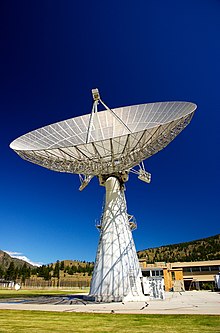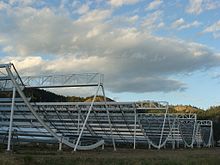Dominion Radio Astrophysical Observatory
The Dominion Radio Astrophysical Observatory (DRAO) is a research facility founded in 1960 located southwest of Penticton , British Columbia , Canada . There is a site for on the interferometer - Radio Astronomy suitable telescope , another 26-meter radio telescope , a system for the measurement of solar radio waves and an interferometric radio telescope. The DRAO is operated by the Herzberg Institute of Astrophysics , a subdivision of the National Research Council of Canada , the Government of Canada .
Radio astronomy interferometer
The DRAO is equipped with seven 9-meter radio telescopes for interferometer radio astronomy, which are distributed over a distance of 600 meters. The antennas are equipped with single and double receivers and operate on a frequency of 408 MHz and 1420 MHz.
26 meter telescope
With the 26-meter telescope one is able to make observations on the frequencies 408 MHz and on 1.5, 2.7, 4.9, 6.6 and 8.4 GHz. Furthermore, you can operate on the frequencies of 1.4, 1.6 and 6.6 GHz.
Solar radio measurement
A telescope that works at a wavelength of 10.7 cm is used to measure the solar radio radiation .
Engineering laboratories
In these laboratories, new reception technologies are researched, tested and constructed. This includes receivers and other components that are important for radio astronomy. Special projects that were carried out in these research facilities are today some parts of the equipment of the Very Large Array in New Mexico , USA and the James Clerk Maxwell Telescope in Hawaii .
CHIME experiment
In 2017 a new telescope was created, the Canadian Hydrogen Intensity Mapping Experiment , or CHIME for short. Construction began in 2013 with a prototype on the site and was completed in 2017, the first light was on September 7, 2018. The telescope consists of four 100 * 20 m large half-cylinders, which are arranged in a north-south direction. The telescope works at wavelengths between 400 and 800 MHz. New fast radio bursts were discovered during the trial run .
Individual evidence
- ↑ https://www.heise.de/newsticker/meldung/Mysterioese-Radioblitze-Teleskop-findet-im-Probelauf-13-neue-Fast-Radio-Bursts-4270404.html
Web links
- Astro Canada - Information about the rig (English)
- The Dominion Radio Astrophysical Observatory (official; English)
- CHIME experiment (official, English)
Coordinates: 49 ° 19 ′ 18 " N , 119 ° 37 ′ 14" W.

